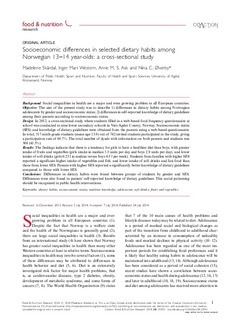| dc.contributor.author | Skårdal, Madalene | |
| dc.contributor.author | Western, Inger Mari | |
| dc.contributor.author | Ask, Anne Selvik | |
| dc.contributor.author | Øverby, Nina Cecilie | |
| dc.date.accessioned | 2014-09-19T12:16:42Z | |
| dc.date.available | 2014-09-19T12:16:42Z | |
| dc.date.issued | 2014 | |
| dc.identifier.citation | Skårdal, M., Western, I. M., Ask, A. M. S. & Øverby, N. C. (2014). Socioeconomic differences in selected dietary habits among Norwegian 13-14 year-olds : a cross-sectional study. Food & Nutrition Research, 58. | nb_NO |
| dc.identifier.issn | 1654-661X | |
| dc.identifier.uri | http://hdl.handle.net/11250/220688 | |
| dc.description.abstract | Background: Social inequalities in health are a major and even growing problem in all European countries.;
Objective: The aim of the present study was to describe 1) differences in dietary habits among Norwegian adolescents by gender and socioeconomic status; 2) differences in self-reported knowledge of dietary guidelines among their parents according to socioeconomic status.
Design: In 2012, a cross-sectional study where students filled in a web-based food frequency questionnaire at school was conducted in nine lower secondary schools in Vest-Agder County, Norway. Socioeconomic status (SES) and knowledge of dietary guidelines were obtained from the parents using a web-based questionnaire. In total, 517 ninth-grade students (mean age 13.9) out of 742 invited students participated in the study, giving a participation rate of 69.7%. The total number of dyads with information on both parents and students was 308 (41.5%).
Results: The findings indicate that there is a tendency for girls to have a healthier diet than boys, with greater intake of fruits and vegetables (girls intake in median 3.5 units per day and boys 2.9 units per day), and lower intake of soft drinks (girls 0.25 l in median versus boys 0.5 l per week). Students from families with higher SES reported a significant higher intake of vegetables and fish, and lower intake of soft drinks and fast food than those from lower SES. Parents with higher SES reported a significantly better knowledge of dietary guidelines compared to those with lower SES.
Conclusions: Differences in dietary habits were found between groups of students by gender and SES. Differences were also found in parents' self-reported knowledge of dietary guidelines. This social patterning should be recognized in public health interventions. | nb_NO |
| dc.language.iso | eng | nb_NO |
| dc.publisher | Swedish Nutrition Foundation | nb_NO |
| dc.rights | Navngivelse-Ikkekommersiell 3.0 Norge | * |
| dc.rights.uri | http://creativecommons.org/licenses/by-nc/3.0/no/ | * |
| dc.title | Socioeconomic differences in selected dietary habits among Norwegian 13-14 year-olds : a cross-sectional study | nb_NO |
| dc.type | Journal article | nb_NO |
| dc.type | Peer reviewed | nb_NO |
| dc.rights.holder | © 2014 The Author(s) | |
| dc.subject.nsi | VDP::Medical disciplines: 700::Health sciences: 800::Nutrition: 811 | nb_NO |
| dc.source.pagenumber | 8 | nb_NO |
| dc.source.volume | 58 | nb_NO |
| dc.source.journal | Food & Nutrition Research | nb_NO |
| dc.identifier.doi | https://doi.org/10.3402/fnr.v58.23590 | |

